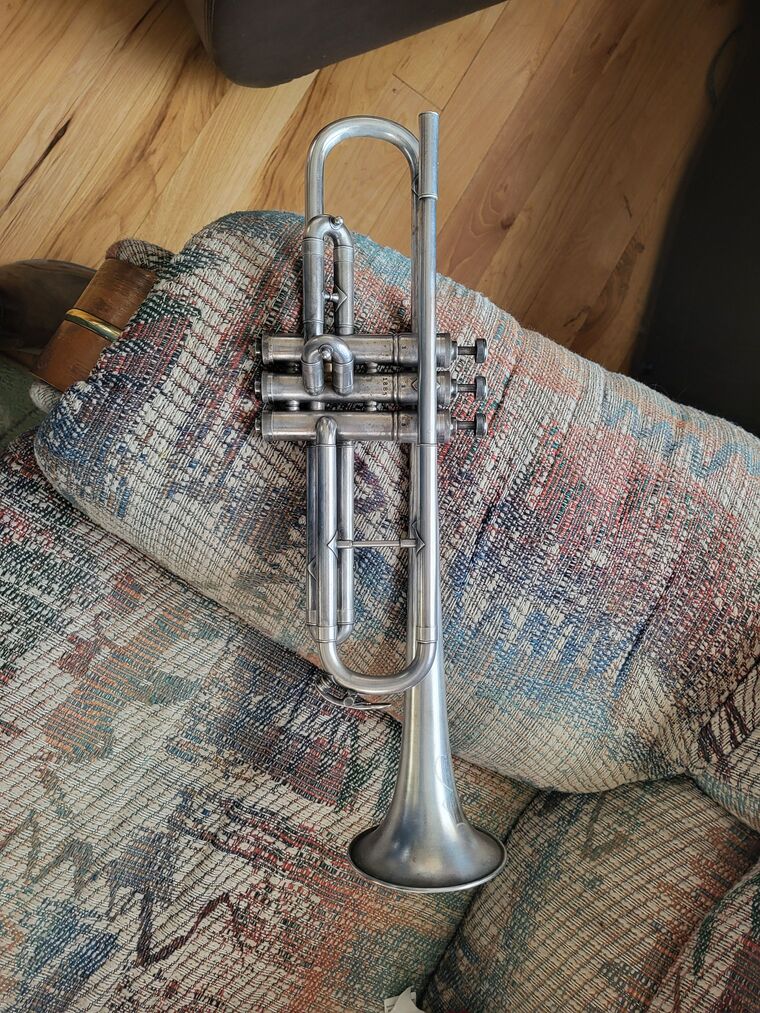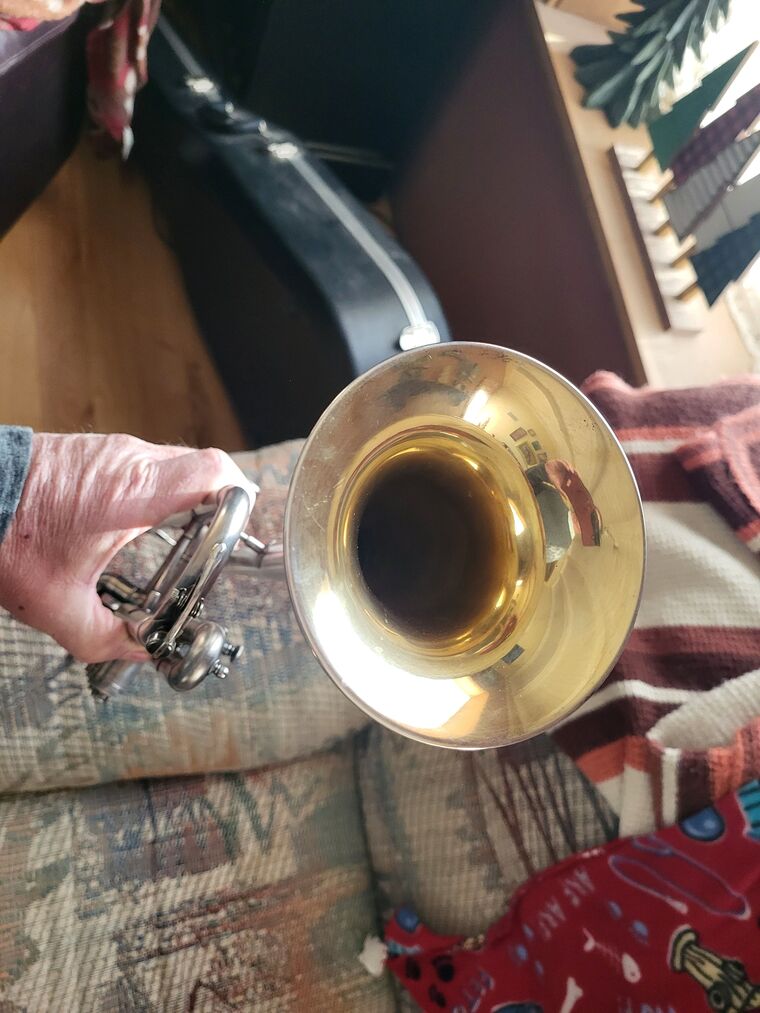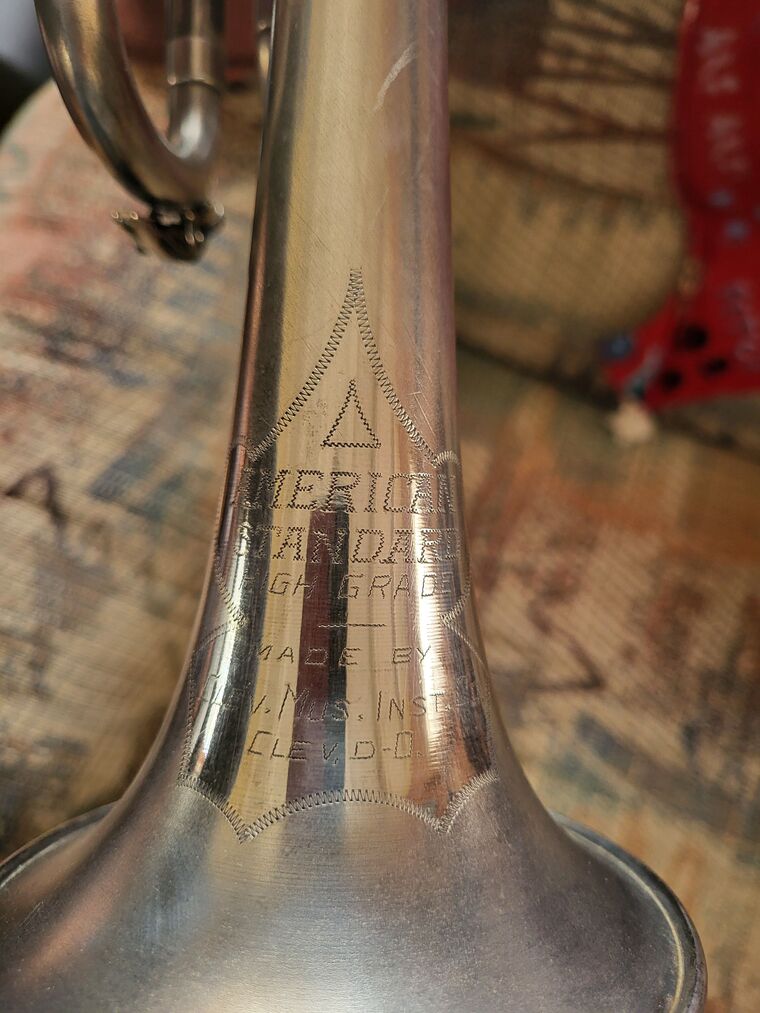Matt silver American Standard High Grade Cleveland
-
Bought a nearly spotless American standard high grade y Cleveland Matt silver with gold plating inside the bell. Super clean after I polished it. Very low number. 1885.
I think early 20s manufacturer. Anyone know much about these? History? Quality? -
Here are some pictures.



-
Nice! From the profile, a typical "peashooter" of the period...
-
@barliman2001 Thanks! I have no idea what a typical pea shooter from that era means. LOL!
-
@jdlmodelt said in Matt silver American Standard High Grade Cleveland:
@barliman2001 Thanks! I have no idea what a typical pea shooter from that era means. LOL!
From Rodd Stewart's discussion of the history of the trumpet, he makes this historical perspective of the peashooter trumpet:
From about 1920, the large US makers also made popular models with very small bell flares for the (mostly amateur) dance band market that wanted a sound that deviated more thoroughly from the old fashioned cornets. This fashion was short lived and these trumpets were replaced around 1930 with narrow, "streamlined" (now sometimes called "peashooter) trumpets with small bell rim diameters that were in fact full size trumpets acoustically. These were popular with dance bands and jazz trumpet players, but disappeared from the market after World War II.
Here is a link to that site by Rodd Stewart. https://www.robbstewart.com/history-of-the-modern-trumpet
-
@Dr-GO Thank you!!! I took this old trumpet out to the garage and played for a while. I'm in SW Colorado and we have some windy cold weather right now so I didn't stay out there for very long but had fun noting that it does seem to take on the higher registers fairly well. It's not a very bright tone. More soft or dull than what I would expect. Nonetheless, it plays decent for what appears to be about a 100 year old instrument that I don't think was played very much at all it's entire life. There is just hardly any wear or damage to be had.
-
@Dr-GO do you know if these Cleveland trumpets were a one piece or two piece bell? I've found one or two other examples of this model or similar model online and noted that my tuning slides are all silver plated inside the slide mating surface but the others I've seen are raw brass inside the tuning slide surfaces. The valves almost look copper to me. I'm assuming it's actually a monel alloy from 100 years ago?
-
IMO this is not a peashooter. One characteristic of most peashooters is that the lower tuning slide enters the valve block on the same side as the bell. Another feature is a tight bell crook wrap. A smaller bell diameter is not uncommon. Also, the valve body is usually short, with bottom sprung valves. Peashooters are known for their bright sound, as well. A quick internet search reveals these examples:
This American Standard has the tight wrap, but with a customary tuning slide entry:

trumpet-history.comHere is a Bohland & Fuchs with the opposite tuning slide entry and all the valve slides on the same side of the valve block:

trumpet-history.com -
@J-Jericho said in Matt silver American Standard High Grade Cleveland:
IMO this is not a peashooter. One characteristic of most peashooters is that the lower tuning slide enters the valve block on the same side as the bell. Another feature is a tight bell crook wrap. A smaller bell diameter is not uncommon. Also, the valve body is usually short, with bottom sprung valves. Peashooters are known for their bright sound, as well. A quick internet search reveals these examples:
This American Standard has the tight wrap, but with a customary tuning slide entry:

trumpet-history.comHere is a Bohland & Fuchs with the opposite tuning slide entry and all the valve slides on the same side of the valve block:

trumpet-history.comInteresting observation. I recently went on a search for trumpets with the tuning slide in that position. I described it as first and third slides on the right side. I have a Nova (Los Angeles) brand cornet and trumpet in that configuration. Since the maker was a music store, I've always wondered where the valve block came from.
Regarding Cleveland instruments, I have many and all seem to have really well functioning valves with remarkable compression despite being 70-80 years old. And I'm not talking remarkable for their age, but equal to most current horns.
-
@Richard-III Many early Buescher trumpets had that "wrong" wrap.
-
I have owned many instruments and one was a peashooter.
The peashooter was often used in dance bands for 3 possible reasons in my opinion.
1 Because they typically had a very tight wrap and were slim and racy looking and audiences loved that.
2 They typically had art deco engravings that looked very progressive and up to date in the 1920s
and 3 They often had a very small bell diameter and this kept the bell flare tight.
The tight bell flare made for a very piercing tone that projected very strongly and powerfully and was said to be able to strip paint from the far wall when played.
I believe this strong projection was helpful in a large dance hall with large band with audiences dancing around and making a lot of noise.
The brighter tone was acceptable as it helped the player rise above all the other instruments much as the lead players do today playing higher brighter and louder.
The drive towards smoother richer and more lyrical instruments through the 40s 50s and 60s I believe led to the abandonment of the pea shooter as dance bands did not need such bright and strident instruments and players found they could achieve much the same effect by a sensible choice of mouthpiece for lead playing.
Peashooter says it all for me, - a thin tube with not much flare resulting in strong projection.
-
I found this document to be very helpful.
-
H. N. White (the maker of King musical instruments) bought the Cleveland Musical Instrument Company in 1925. Cleveland’s line of instruments were named “American Standard”, and had a good reputation for being quality instruments for the price. H. N. White bought the company to provide a line (Cleveland) of less expensive instruments to go with his King line.
-
@jdlmodelt I have a similar American Standard. It didn't seem like a particularly good horn (valves were pretty ordinary) and so I conducted some surgery and turned it into a C horn as a fun experiment. FWIW, it sounds ok and plays pretty much in tune, and the valves are still ordinary. It's waiting for me in the workshop to get enthused enough to tidy up the soldered joints and finish it.
If yours makes you happy keep it, if you want to flip it, check pricing on ebay.
cheers
tj -
Locked by
 barliman2001
barliman2001